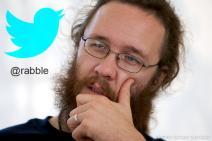Surprised when demonstrators from all over the world took to Twitter as a protest tool? Evan “Rabble” Henshaw-Plath, member of Twitter’s founding team, was not. Rather, he sees it as a return to its roots: Inspired by protest coordination tools like TXTMob, and shaped by the values and backgrounds of Twitter’s founders, he believes activist potential was built into the service from the start.
It took a few revolutions before Twitter was taken seriously. Critics claimed that its 140-character limit only provided space for the most trivial thoughts: neat for keeping track of Ashton Kutcher’s lunch choices, but not much else. It made the transition from Silicon Valley toy into Middle East protest tool seem all the more astonishing.
Unless, Twitter co-founder Evan Henshaw-Plath argues, you know the story of how Twitter came to be. Evan Henshaw-Plath was the lead developer at Odeo, the company that started and eventually became Twitter. TXTMob, an activist tool deployed during the 2004 Republican National Convention in the US to coordinate protest efforts via SMS was, says Henshaw-Plath, a direct inspiration for Twitter.
Protest 1.0
In 2004, while Henshaw-Plath was working at Odeo, he and a few other colleagues found a fun side-project in working on TXTMob, an initiative by what he describes as a “group of academic artist/prankster/hacker/makers” that operated under the ostensibly serious moniker of Institute for Applied Autonomy (IAA). Earlier IAA projects included small graffiti robots on wheels that spray painted slogans on pavements during demonstrations, and a pudgy talking robot with big puppy eyes made to distribute subversive literature to people who ignored less-cute human pamphleteers.
TXTMob was a more serious endeavor than these earlier projects: a tactical protest coordination tool. With TXTMob, users could quickly exchange text messages with large groups of other users about protest locations and police crackdowns.
Global tech-support
Henshaw-Plath understood the need for such a tool from personal experience. During the years previous to his work at Odeo, he had often been involved in protests and activism himself. He spent several years travelling the world, “basically serving as the tech support of the anti-globalisation movement.” And he didn’t just stay behind his computer, he was even deported from the Czech Republic after protesting at the 2000 IMF World Bank meeting.
“This was the time before smartphones,” Henshaw-Plath recalls. “People were carrying around radios and setting up pirate radio stations to communicate what was going on elsewhere in the protest—also for massive mobilisations with tens or hundreds thousands of people. It was very hard to figure out what was going on.”
So when Henshaw-Plath, Odeo colleague Blaine Cook and some friends discovered TXTMob, they immediately thought “it was very cool”, although also “very poorly written.” They decided to help rework TXTMob’s back end so it could handle IAA’s big protest plans for the 2004 Republican National Convention.
The birth of Twttr
In 2006, when social network MySpace still reigned supreme, and friends chatted over MSN Messenger, a text message-based social network seemed intriguing, so Henshaw-Plath and colleagues at Odeo took a closer look at TXTMob. During a brainstorming day, Jack Dorsey and a few others came up with a promising new idea: Twttr—Twitter’s vowel-less prototype. Like TXTMob, Twttr was a social network and worked via SMS only. But unlike TXTMob, Jack Dorsey simply pitched it as a way to let friends know that the club you’re at is happening.
Click here to watch a video of an early Twitter pitch
In what Henshaw-Plath considers a “major innovation,” Jack Dorsey conceived the idea of the follower relationship, which radically reversed the direction of the information stream. “Instead of deciding who you are sending the messages too, you decide who you are listening to. That’s how Twitter could scale, and it’s the opposite of something like broadcast television.”
A new power dynamic
For Henshaw-Plath, that innovation was another way in which Twitter expressed “the core values” of its founders, a major one being the belief in the importance of participatory media. Those same values, he says led to the idea that messages can be searched and seen by all the site visitors, instead of only by other users or followers. They also inspired Twitter’s open API—which meant developers could create and launch apps for Twitter without requiring prior approval, as is the custom at Google and Facebook. Such a technical difference might seem insignificant, but Henshaw-Plath believes it led to a “very different power dynamic.”
Twitter’s future
Only three months after its invention, Henshaw-Plath left Twitter—thinking there “was nothing in it that indicated it was a world-changing idea.” For a few years he remained “peripherally involved”, able to access all the servers and follow Twitter’s code as the site tried to keep up with its breakneck growth.
Eventually, he also watched as Twitter’s initial openness to developers and hunger for innovation died down. Twitter has started to impose more and more restrictions on its API, for example by virtually prohibiting apps from attracting over 100,000 users.
To Henshaw-Plath, this slowdown is a consequence of the fact none of the original Twitter team members have a day-to-day involvement with the company any longer. “When you are a founder, it’s your baby. You’re willing to make much more radical changes, because you have a connection to that original vision.”
Nonetheless, while Twitter may no longer push the boundaries in ways that some of its original founders would have wanted, Henshaw-Plath thinks its activist origins can never be truly erased. “Most of it will remain,” he believes, “embedded in code.”










